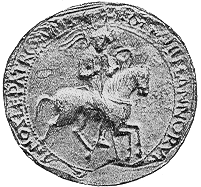





If you are looking at this page without frames, there is more information about medieval writing to be found by going to the home page (framed) or the site map (no frames).
| Law and Administration (3) | ||||||
| England had been on the very fringes of the Roman Empire and the waves of invaders who entered it had a very different way of doing business. Other places were not so drastically treated and certain aspects of the literate Roman mode of conducting affairs survived to some degree. The papal chancery had a continuous history of the literate mode and papal documents had some distinctive features of their own, including the use of papyrus, the lead bulla or seal and some exquisitely extravagant penmanship. | ||||||
 |
 |
|||||
| Small detail from a privilege of Pope Leo IV of AD 850 (Rome, Biblioteca Vaticana, Sala dei papiri, I), showing the elongated calligraphy of curialis script over the distinctive texture of papyrus. On the right the lead seals. (From Steffens 1929) | ||||||
| The Merovingian kings of Francia, who were Germanic barbarian invaders and precursors to Charlemagne's Holy Roman Empire, adopted something of the Roman literate mode in that they had a royal chancery which produced diplomas in their own distinctive Merovingian chancery script. This had some characteristics in common with the curialis of the papacy, as well as the fact that up until the 7th century it was written on papyrus. Also in common with antique legal forms was the fact that they had signatures written in the issuer's own hand. The inclusion of a date also suggests a significance for the words on the page. The diploma was not just a ceremonial object. (See Bischoff 1990) | ||||||
 |
Below the main text is a wiggly symbol called a Chrismon, representing the name Christ, a notary's name followed by his sign with an inscription in Tironian notes. A seal is attached to the page followed by a monogram for Bene valete. The date is written across the bottom following another Chrismon symbol. The script is very hard to read, but the document is packed with coded information. | |||||
| The bottom of a diploma of Childebert III of AD 695 (Paris, Archives Nationales, K.3, Nr.9). (From Steffens 1929) | ||||||
| By the time of Pippin, the father of Charlemagne, kings had become either less capable of writing or more inclined to grand symbolic behaviour as they only added a ceremonial stroke or two to the cross or monogram of the king. | ||||||
 |
The monogram and name of Pippin on a diploma of 760 AD (Marburg, K. Preussisches Staatsarchiv). (From Steffens 1929) | |||||
| While documents were being issued from central authorities bestowing privilege or issuing instructions, evidence for the systematic archiving of them is slower to appear. Cartularies were maintained mainly from the 10th and 11th centuries by the recipients of benefit by charter. However, by then there could be some embarrassing gaps as privileges believed to have been bestowed were not authenticated by written record. The forging of charters or cartulary entries could make up the shortfall, but this should not be seen as a coldblooded fraud. It represents a significant turning point in the change from authentication by oral testimony to authentication by the written word. | ||||||
 |
||||||
| This charter (British Library, Egerton Charter 2211) is a forgery produced in the 1150s but purporting to be from the time of William II. By permission of the British Library. (See Searle 1968). | ||||||
| In England after the Norman Conquest the massive compilation of Domesday Book, which contrary to popular belief did not contain a reference to every pig and chicken in the land, was nevertheless the most ambitious attempt ever to compile and conserve a written record of the condition of the country. The final product survives, but not the archive of documents and reports which would have been necessary for its construction. There are contemporary references to such an archive, but it vanished without trace. Systematic archival preservation was still some way in the future, as was the concept of the written word as a resource for law and government. | ||||||
| The centralisation of royal authority had implications for the development of chanceries and archives. Anglo-Saxon kings received petitions from their subjects in person. However if every perceived injustice in the land was nominally at the king's discretion to resolve, then a system of written communication and record allowed that lump of sculpted sealing wax known as the great seal to impersonate the presence of the king, who had more to do all day than listen to the whinges of his subjects from the length and breadth of the land. If taxes and dues were paid to the exchequer from all corners, they needed to be recorded. If all criminal justice was ultimately under the authority of the king, rather than leaving villages, manors or local areas to attend to it themselves as best they saw fit, then legal process had to be recorded. |  |
|||||
| The great seal of William the Conqueror. | ||||||
|
|
||||||
|
|
||||||
|
If you are looking at this page without frames, there is more information about medieval writing to be found by going to the home page (framed) or the site map (no frames). |
||||||